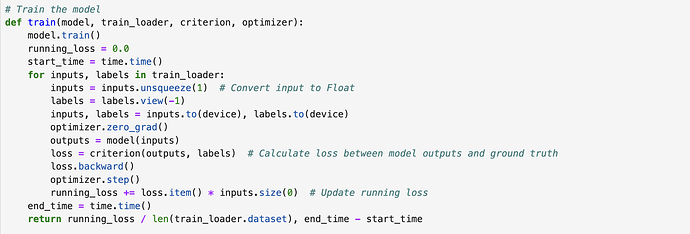Split the image paths into training and validation sets
train_images = final_gray_images[:92677]
train_labels = labels[1:92678]
val_images = final_gray_images[92678:115845]
val_labels = labels[92679:115846]
Print the lengths of training and validation sets
print(“shape of training images:”, train_images.shape)
print(“shape of training labels:”, train_labels.shape)
print(“shape of validation images:”, val_images.shape)
print(“shape of validation labels:”, val_labels.shape)
import torch
import torch.nn as nn
import torch.optim as optim
from torch.utils.data import DataLoader, TensorDataset
from sklearn.preprocessing import LabelEncoder
Checking if CUDA (GPU) is available
device = “cuda” if torch.cuda.is_available() else “cpu”
print(f"Using device: {device}")
Create a label encoder
label_encoder = LabelEncoder()
Fit the label encoder on the entire labels array
label_encoder.fit(labels)
Transform the labels to numerical labels
train_labels_encoded = label_encoder.transform(train_labels)
val_labels_encoded = label_encoder.transform(val_labels)
Convert NumPy arrays to PyTorch tensors and move to the GPU
train_tensor = torch.tensor(train_images).float().to(device)
train_labels_tensor = torch.from_numpy(train_labels_encoded).long().to(device)
val_tensor = torch.tensor(val_images).float().to(device)
val_labels_tensor = torch.from_numpy(val_labels_encoded).long().to(device)
torch.cuda.empty_cache()
Create TensorDatasets
train_dataset = TensorDataset(train_tensor, train_labels_tensor)
val_dataset = TensorDataset(val_tensor, val_labels_tensor)
Create DataLoaders
train_loader = DataLoader(train_dataset, batch_size=1000, shuffle=False)
val_loader = DataLoader(val_dataset, batch_size=1000, shuffle=False)
class CNNModel(nn.Module):
def init(self):
super(CNNModel, self).init()
self.conv1 = nn.Conv2d(1, 64, kernel_size=3, padding=1)
self.relu1 = nn.ReLU(inplace=True)
self.maxpool1 = nn.MaxPool2d(kernel_size=2, stride=2)
self.conv2 = nn.Conv2d(64, 128, kernel_size=3, padding=1)
self.relu2 = nn.ReLU(inplace=True)
self.maxpool2 = nn.MaxPool2d(kernel_size=2, stride=2)
self.conv3 = nn.Conv2d(128, 256, kernel_size=3, padding=1)
self.relu3 = nn.ReLU(inplace=True)
self.conv4 = nn.Conv2d(256, 256, kernel_size=3, padding=1)
self.relu4 = nn.ReLU(inplace=True)
self.maxpool3 = nn.MaxPool2d(kernel_size=2, stride=2)
self.conv5 = nn.Conv2d(256, 512, kernel_size=3, padding=1)
self.relu5 = nn.ReLU(inplace=True)
self.conv6 = nn.Conv2d(512, 512, kernel_size=3, padding=1)
self.relu6 = nn.ReLU(inplace=True)
self.maxpool4 = nn.MaxPool2d(kernel_size=2, stride=2)
self.avgpool = nn.AdaptiveAvgPool2d((7, 7))
self.fc = nn.Linear(512 * 7 * 7, 1000)
def forward(self, x):
x = self.conv1(x)
x = self.relu1(x)
x = self.maxpool1(x)
x = self.conv2(x)
x = self.relu2(x)
x = self.maxpool2(x)
x = self.conv3(x)
x = self.relu3(x)
x = self.conv4(x)
x = self.relu4(x)
x = self.maxpool3(x)
x = self.conv5(x)
x = self.relu5(x)
x = self.conv6(x)
x = self.relu6(x)
x = self.maxpool4(x)
x = self.avgpool(x)
x = torch.flatten(x, 1)
x = self.fc(x)
return x
Move the model to the GPU if available
model = CNNModel().to(device)
criterion = nn.CrossEntropyLoss()
optimizer = optim.Adam(model.parameters(), lr=0.001)
Train the model
def train(model, train_loader, criterion, optimizer):
model.train()
running_loss = 0.0
start_time = time.time()
for inputs, labels in train_loader:
inputs = inputs.unsqueeze(1) # Convert input to Float
labels = labels.view(-1)
inputs, labels = inputs.to(device), labels.to(device)
optimizer.zero_grad()
outputs = model(inputs)
loss = criterion(outputs, labels) # Calculate loss between model outputs and ground truth
loss.backward()
optimizer.step()
running_loss += loss.item() * inputs.size(0) # Update running loss
end_time = time.time()
return running_loss / len(train_loader.dataset), end_time - start_time
Validation function
def validate(model, val_loader, criterion):
model.eval()
start_time = time.time()
with torch.no_grad():
running_loss = 0.0
correct_preds = 0
total_preds = 0
for inputs, labels in tqdm(val_loader):
inputs = inputs.to(device)
labels = labels.to(device)
outputs = model(inputs)
loss = criterion(outputs, labels)
running_loss += loss.item() * inputs.size(0)
# Calculate accuracy
_, preds = torch.max(outputs, 1)
correct_preds += torch.sum(preds == labels).item()
total_preds += inputs.size(0)
end_time = time.time()
val_loss = running_loss / len(val_loader.dataset)
val_accuracy = correct_preds / total_preds
return val_loss, val_accuracy, end_time - start_time
Training loop
num_epochs = 10
for epoch in range(num_epochs):
train_loss, train_time = train(model, train_loader, criterion, optimizer)
val_loss, val_accuracy, val_time = validate(model, val_loader, criterion)
print(f’Epoch {epoch+1}/{num_epochs}, Train Loss: {train_loss:.4f}, Train Time: {train_time:.2f}s, ’
f’Val Loss: {val_loss:.4f}, Val Accuracy: {val_accuracy:.4f}, Val Time: {val_time:.2f}s’)
This is the code I’m running. I’m using ImageNet-LT dataset which has 1000 classes. While training the model I’m facing the issue. Can you please help me with this.

